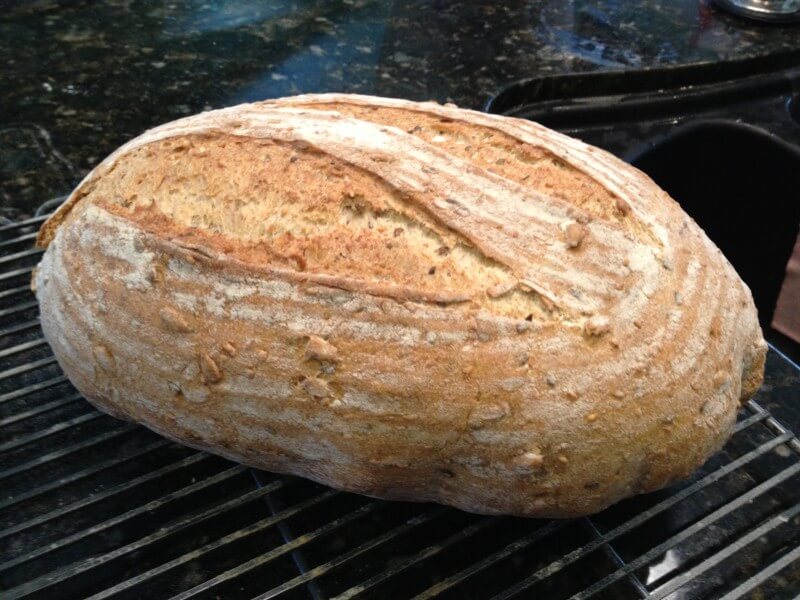Ingredients
Day 1
- 200 g white bread flour
- 1/4 tsp instant yeast (NOT MORE)
- 200 g room temperature water
Day 2
- 100 g sourdough starter
- 120 g lukewarm water
- 12 g olive oil
- 100 g white bread flour
- 200 g spelt flour
- 12 g salt
- 6 g instant dry yeast (remainder of packet from previous day)
- 1 tsp diastic malt powder
- 80 g sunflower seeds
- 40 g sesame seeds
- 20 g golden flax seeds
- 1/4 tsp gelatin powder
Method
Day 1: Afternoon of the day before baking
- Combine flour and yeast add water. Stir together thoroughly.
- Let sit for 4 hours at room temperature until bubbly and then refrigerate over night.
Day 2: Baking Day
- The first thing in the morning:
- Take the stand mixer bowl and sourdough jar out of the fridge to let them acquire room temperature. Try to maintain the room temperature at 70°/75°.
- Combine sourdough starter and lukewarm water. Mix well with a fork. Do not whisk. Combine this with the previous days mixture. Add olive oil. Blend together with S-Hook. In a separate bowl, whisk together all dry ingredients except gelatin. Then add to the mixing bowl. Knead with the S-hook and scrape the side of the bowl only until all is combined. Cover with plastic—a shower cap works well—and let rest 15 minutes to hydrate the flour. Then machine-knead for 7 additional minutes, scraping the bowl and clearing the hook as needed. Remove the dough from the bowl onto the lightly floured kitchen counter. Hand-knead with the help of the scraper until the ball of dough feels right. Form a clump and put into the lightly oiled stand mixer bowl. Mist-oil the top of the dough. Seal the bowl with the shower cap and let ferment at room temperature until it is doubled in volume, which will take about one hour. To test if the fermentation is at that point, dimple the dough with your floured finger. If the dimple remains the fermentation is done. Do not let ferment any longer!
- Set the oven rack and the dry Römertopf to the lowest shelf position. Preheat the oven to 500°.
- Pour into a small dish:
- ¼ cup cool water and sprinkle with gelatin powder. Let soak for a couple of minutes and then stir together. The solution is used later on to hold the sprinkled seeds in place.
- Remove the dough from the bowl onto the lightly floured kitchen counter. Gently, to avoid deflating the dough, knead and stretch the dough a few times to re-activate the yeast. Then shape into a loaf to fit the banneton. Brush the top and sides of the loaf with the water/gelatin mixture and sprinkle with sesame seeds. Place the loaf, seeded side down, onto a square piece of parchment paper. Lift the loaf by the parchment paper and place into the banneton. Cover with a towel and proof at room temperature for 30 minutes. At that point, brush the exposed surface of the loaf with the water/gelatin mixture and sprinkle with sesame seeds. Slash the top of the loaf so that steam can escape during baking. Cover again and continue proofing until the loaf is well swollen, but short of being doubled to avoid collapsing. Take the Römertopf base out of the oven and close the oven door again to retain the heat. Lift the dough by the parchment paper and place into the 500° pre-heated Römertopf base. Fold excess paper out or trim off quickly. Place on the lid and set the Römertopf into the oven. Reduce the heat setting to 475° and bake for 30 minutes. Perhaps try 450° and adjust the timing. Remove the lid and insert the oiled probe of a remote thermometer into the center of the loaf. The internal temperature should register not less than 197°. If necessary, continue baking at 450° until the color is right and the required temperature is reached.
Good to Know
For a rye bread version, replace spelt with half light rye flour and half dark rye flour. Skip the seeds and replace with seasonings of your liking like caraway, fennel, anise, and coriander.
For basic sourdough, replace spelt flour with same amount of white bread flour.
You can also replace 100 g of the white flour with whole wheat which gives the bread a little more texture.




